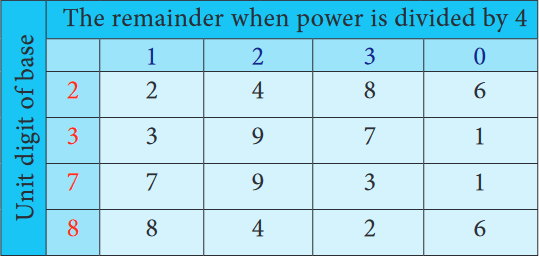UNIT DIGIT OF NUMBERS IN EXPONENTIAL FORM
Subscribe to our ▶️ YouTube channel 🔴 for the latest videos, updates, and tips.
Manipulating with exponent is very interesting and funny too.
We know that
93 = 9 x 9 x 9 = 729,
thus the unit digit (the last number of expanded form) of 93 is 9.
Similarly,
44 = 4 x 4 x 4 x 4 = 256
Thus the unit digit of 44 is 6.
Can you guess the unit digit of 230116 , 18147 , 554, 5620 and 929?
It is very difficult to find by expanding the exponential form. But, we can try to tell the unit digit by observing some patterns.
Look at the following number pattern.
103 = 10 x 10 x 10 = 1000
104 = 10 x 10 x 10 x 10 = 10000
105 = 10 x 10 x 10 x 10 x 10 = 100000
Thus, multiplying 10 by itself several times, we always get the unit digit as 0. In other words, 10 raised to the power of any number has the unit digit 0. That is, the unit digit of 10x is always 0, for any positive integer x. This is also true when the base is multiples of 10.
Consider,
402 = (4 x 10)2
= 42 x 102
= 16 x 100
= 1600
Similarly,
230116 = (23 x 10)116
= 23116 x 10116
Thus, the unit digit of 230116 is 0.
Now, observe that,
15 = 1 x 1 x 1 x 1 x 1 = 1
16 = 1 x 1 x 1 x 1 x 1 x 1 = 1
We learnt to expand 11 as 10 + 1. So,
(10 + 1)2 = 112 = 11 x 11 = 121
Similarly,
131 = 130 + 1
= (13 x 10) + 1
[(13 x 10) + 1]2 = 1312
= 131 x 131
= 17161
Hence, if the exponential number is in the form
1x or [(multiple of 10) + 1]x,
then the unit digit is always 1, where x is a positive integer. Therefore, the unit digit of 18147 is 1.
Similarly, by observing the following patterns, we can conclude that the unit digit of number with base ending with 5 is 5 and number with base ending with 6 is 6.
|
51 = 5 52 = 5 x 5 = 25 53 = 5 x 5 x 5 = 125 |
61 = 6 62 = 6 x 6 = 36 63 = 6 x 6 x 6 = 216 |
Therefore, the unit digit of 554 = (50 + 5)4 is 5.
And the unit digit of 5620 = (50 + 6)20 is 6.
We conclude that, for the base number whose unit digits are 0, 1, 5 and 6 the unit digit of a number corresponding to any positive exponent remains unchanged.
Look into the following example. Observe the pattern of unit digit when the base is 4.
41 = 4 (odd exponent)
43 = 4 x 4 x 4 = 64 (odd exponent)
45 = 4 x 4 x 4 x 4 x 4 = 1024 (odd exponent)
42 = 4 x 4 = 16 (even exponent)
44 = 4 x 4 x 4 x 4 = 256 (even exponent)
46 = 4 x 4 x 4 x 4 x 4 x 4 = 4096 (even exponent)
Note that for base ending with 4, the unit digit of the expanded form alternates between 4 and 6. Further we can notice when the exponent is odd its unit digit is 4 and when the exponent is even it is 6.
Similarly, when the base unit is 9,
91 = 9 (odd exponent)
93 = 9 x 9 x 9 = 729 (odd exponent)
95 = 9 x 9 x 9 x 9 x 9 = 59049 (odd exponent)
92 = 81 (even exponent)
94 = 9 x 9 x 9 x 9 = 6561 (even exponent)
96 = 9 x 9 x 9 x 9 x 9 x 9 = 531441 (even exponent)
Thus, for base ending with 9, the unit digit after the expansion is 9 for odd exponent and is 1 for even exponent.
As we have seen in the earlier case, this rule is applicable, when the base is in the form of
[(multiple of 10) + 4] or [(multiple of 10) + 9]
For example, consider 2412.
Here, unit digit of the base 24 is 4 and the exponent is 12 (even exponent).
Therefore, unit digit of 2412 is 6.
Similarly consider, 8921.
Here, unit digit of the base 89 is 9 and the exponent is 21 (odd exponent).
Therefore, unit digit of 8921 is 9.
We conclude that, for base ending with 4, the unit digit of the expanded form is 4 for odd power and is 6 for even power. Similarly, for base ending with 9, the unit digit of the expanded form is 9 for odd power and is 1 for even power. Remember, 4 and 6 are complements of 10. Also, 9 and 1 are complements of 10.
Solved Problems
Problems 1-10 : Find the unit digit of the given exponential number.
Problem 1 :
2523
Solution :
Unit digit of the base 25 is 5 and the exponent is 23.
Therefore, the unit digit of 2523 is 5.
Problem 2 :
81100
Solution :
Unit digit of the base 81 is 1 and the exponent is 100.
Therefore, the unit digit of 81100 is 1.
Problem 3 :
4631
Solution :
Unit digit of the base 46 is 6 and the exponent is 31.
Therefore, the unit digit of 4631 is 6.
Problem 4 :
10621
Solution :
Unit digit of the base 106 is 6 and the exponent is 21.
Therefore, the unit digit of 10621 is 6.
Problem 5 :
258
Solution :
Unit digit of the base 25 is 5 and the exponent is 8.
Therefore, the unit digit of 258 is 5.
Problem 6 :
3118
Solution :
Unit digit of the base 31 is 1 and the exponent is 18.
Therefore, the unit digit of 3118 is 1.
Problem 7 :
2010
Solution :
Unit digit of the base 20 is 0 and the exponent is 10.
Therefore, the unit digit of 2010 is 0.
Problem 8 :
47
Solution :
Unit digit of the base 4 is 4 and the exponent is 7 (odd exponent).
Therefore, the unit digit of 47 is 4.
Problem 9 :
6410
Solution :
Unit digit of the base 64 is 4 and the exponent is 10 (even exponent).
Therefore, the unit digit of 6410 is 6.
Problem 10 :
912
Solution :
Unit digit of the base 9 is 9 and the exponent is 12 (even exponent).
Therefore, the unit digit of 912 is 1.
Problem 11 :
4917
Solution :
Unit digit of the base 49 is 9 and the exponent is 17 (odd exponent).
Therefore, the unit digit of 4917 is 9.
Problem 12 :
6411
Solution :
Unit digit of the base 64 is 4 and the exponent is 11 (odd exponent).
Therefore, the unit digit of 6411 is 4.
Problem 13 :
2918
Solution :
Unit digit of the base 29 is 9 and the exponent is 18 (even exponent).
Therefore, the unit digit of 2918 is 1.
Problem 14 :
10432
Solution :
Unit digit of the base 104 is 4 and the exponent is 32 (even exponent).
Therefore, the unit digit of 10432 is 6.
Problem 15 :
7919
Solution :
Unit digit of the base 79 is 9 and the exponent is 19 (odd exponent).
Therefore, the unit digit of 7919 is 9.
Activity
The following activity will help you to find the unit digits of exponent numbers whose base is ending with 2, 3, 7 and 8.
Observe the table given below. The numbers in first column, that is 2, 3, 7 and 8 denotes the unit digit of base of the given exponent number and the numbers in the first row, that is 1, 2, 3 and 0 stands for the remainder when power is divided by 4.

For example, consider 26.
Unit digit of the base 2 is 2 and the exponent is 6. When the exponent 6 is divided by 4, we get the remainder 2.
From the table, we see that 2 and 2 corresponds to 4. Therefore, the unit digit of 26 is 4.To verify,
26 = 2 x 2 x 2 x 2 x 2 x 2 = 64
Similarl, consider 11720.
Unit digit of the base 117 is 7 and the exponent is 20. When the exponent 20 is divided by 4, we get the remainder 0.
From the table, we see that 7 and 0 corresponds to 1. Therefore, the unit digit of 11720 is 1.
Now, you can extend this activity for finding the unit digits of any exponent number whose base is ending with any of 2, 3, 7 or 8.
Subscribe to our ▶️ YouTube channel 🔴 for the latest videos, updates, and tips.
Kindly mail your feedback to v4formath@gmail.com
We always appreciate your feedback.
About Us | Contact Us | Privacy Policy
©All rights reserved. onlinemath4all.com

Recent Articles
-
GMAT Quantitative Reasoning Questions and Answers
Dec 27, 25 09:33 PM
GMAT Quantitative Reasoning Questions and Answers -
10 Hard SAT Math Questions (Part - 40)
Dec 25, 25 08:30 AM
10 Hard SAT Math Questions (Part - 40) -
10 Hard SAT Math Questions (Part - 41)
Dec 24, 25 07:58 PM
10 Hard SAT Math Questions (Part - 41)

